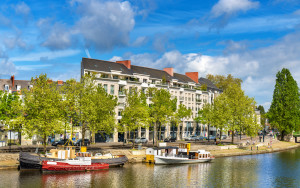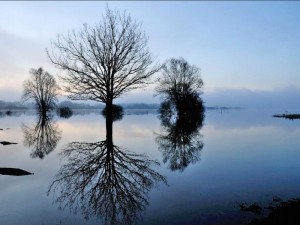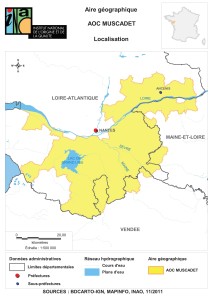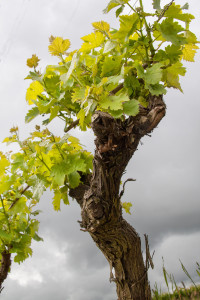
The Erdre River at Nantes
There are some people that consider Muscadet to be a rather uninteresting wine. After all (they may argue), it’s old-fashioned, it is a mono-cépage (wine produced from a single grape variety), and the grape itself—Melon de Bourgogne—is rather neutral in aromas and flavors.
Others would argue that Muscadet—the leading wine of the Loire Valley’s Pays Nantais and produced in four separate appellations including Muscadet AOC, Muscadet Sèvre-et-Maine AOC, Muscadet Côtes de Grandlieu AOC, and Muscadet Coteaux de la Loire AOC—is complex, delicious, and fascinating. After all, the Pays Nantais is itself somewhat complicated, with a great diversity in its topography, soils, and micro-climates. Combine that with the fact that the wine is often put through sur lie aging, and you have a region that can produce a wine that may show up in a variety of styles from light, citrus, and mineral-scented to rich, yeasty, and full of tropical fruit flavors.
While we’re on the subject of Muscadet, here are a few more fascinating facts about the grape, the wine, and the region:
The Year was 1937: The Muscadet AOC was originally approved on September 23, 1937—making it one of the oldest AOCs for wine in France. The very first wine-specific AOCs were approved on May 15, 1936.

Photo of Lake Grand-Lieu via www.france-voyage.com
La Lac de Grand-Lieu: Lake Grand Lieu (La Lac de Grand-Lieu) is located about 8 miles (14 km) south of the city of Nantes. The lake stretches across 6,000 hectares in winter, when it is considered the largest natural lake in France. Lake Grand Lieu was ceded to the country of France in the early 1980s under the condition that it be declared a national nature reserve. The lake contains four distinct habitats—including open water, a water lily bed, a reed bed and several meadows that flood for six to eight months a year. More than 500 species of plants make their home on the lake, and over 270 species of birds fly through the region each year along their migratory route towards the Atlantic Coast. The area is also home to ducks, geese, otters, and frogs. As the lake is 100% a nature preserve, access is limited and most forms of boating and fishing are not allowed. However, there are 7 members of the traditional fishing community that have been assigned a special authorization to fish during certain times of the year.
Le Muscadet Nouveau est arrivé: Muscadet AOC is allowed to be bottled using the term “Nouveau” or “Primeur.” Muscadet Nouveau AOC may be released on the third Thursday of November (which is, it seems, a very good day to host a wine party).

Map of the Muscadet AOC via the INAO
The Muscadet AOC: The Muscadet AOC is large area, starting just east of the place where the Loire River meets the Atlantic Coast and extending inland for almost 55 miles (90 km) to the western edge of the Anjou District. The majority of the area is located within the Loire-Atlantique Département, but small portions extend into the Maine-et-Loire and Vendée Département as well. Many of the vineyards are located to the south and east of the city of Nantes; others are concentrated along the Loire River (and its famous tributaries, including the Sèvre, the Erdre, and the Maine) as well as the area surrounding Grand Lieu Lake.
Clisson, Gorges, and Le Pallet: The Muscadet Sèvre-et-Maine AOC, tucked between the Sèvre and the Maine Rivers close to where they flow northwest in the Loire River, contains three (smallish) sub-regions: Clisson, Gorges, and Le Pallet. These three sub-regions are delineated based on soil types—Clisson is granite-based, Gorges rests on clay and gabbro, and Le Pallet is known for gneiss and quartz. Wines labeled with these sub-regions—often referred to as crus—must be produced from grapes grown on these soils. The three sub-regions also have varying requirements for sur lie aging and total aging before release, and wine are often aged on the lees for two years or more. Click here for a map of the sub-regions of the Muscadet Sevre et Maine AOC, via the INAO.

.
Le Grand Hiver: On January 5, 1709, much of Northern Europe woke up to a deep freeze. The freezing temperatures—which spread from England (where they called it “The Great Frost”) across France (where they called it Le Grand Hiver) and Northern Italy, through Scandinavia and parts of Russia—lasted almost three months. This was considered to be the coldest winter in Europe in over 500 years. During this time, Elizabeth Charlotte, the Duchess of Orléans wrote a letter from her Loire Valley home exclaiming, “Never in my life have I seen a winter such as this one; the wine freezes in bottles.” Not long after The Great Frost, red grapes were outlawed in Nantes and the area became (for a time) a white wine-only region. It was during this time that the cold-hardy Melon de Bourgogne grape came to dominate the vineyards of the Pays Nantais.
References/for more information:
- https://www.france-voyage.com/cities-towns/saint-philbert-de-grand-lieu-15684/lake-grand-lieu-32854.htm
- https://www.france-voyage.com/cities-towns/saint-philbert-de-grand-lieu-15684/lake-grand-lieu-32854.htm
- More on the letters of Liselotte (Elizabeth Charlotte, the Duchess of Orléans): http://rodama1789.blogspot.com/2016/06/the-winter-of-1709-letters-of-liselotte.html
- https://www.newscientist.com/article/mg20126942-100-1709-the-year-that-europe-froze/
- https://www.guildsomm.com/learn/study/w/study-wiki/154/loire-valley#02
- https://www.loirevalley-france.co.uk/outings/nature-strolls/wealth-flourishing-natural-spaces/grand-lieu-lake-vast-bird-reserve
- https://www.winemag.com/2018/06/25/loire-valley-muscadet/
Post authored by Jane A. Nickles, your blog administrator…